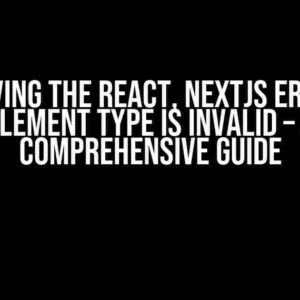Are you tired of dealing with cumbersome and confusing state management in your React applications? Do you find yourself lost in a sea of componentWillReceiveProps, shouldComponentUpdate, and setState callbacks? Fear not, dear developer, for we have good news! In this article, we’ll explore a cleaner and more concise way of handling states in React, specifically designed to simplify your code and streamline your development process.
Understanding the Problem
Before we dive into the solution, let’s take a step back and understand the problem at hand. Traditional state management in React involves using the setState method to update the component’s state, which can lead to:
- Complex and hard-to-debug code
- Over-reliance on lifecycle methods (e.g., componentWillReceiveProps, shouldComponentUpdate)
- Inconsistent state updates, leading to errors and bugs
This is where the concept of “State Management” comes into play. In React, state management refers to the process of managing and updating the state of a component in a predictable and efficient manner.
Enter: Redux and Context API
In recent years, two popular state management solutions have emerged: Redux and React Context API. While both solutions are effective, they have their own set of complexities and learning curves.
Redux
Redux is a predictable, container-based state management system that promotes a single source of truth for application state. It consists of three main components:
- Action creators: Functions that create actions to update the state
- Reducers: Pure functions that update the state based on actions
- Stores: Single sources of truth for application state
While Redux provides a solid foundation for state management, it can be overwhelming for smaller applications or those new to React.
Context API
The React Context API is a built-in state management system that allows components to share data without passing props down manually. It consists of three main components:
- Context Providers: Components that provide context values to their children
- Context Consumers: Components that subscribe to context values
- Context API Hooks: Hooks that provide access to context values
While the Context API is a simpler and more lightweight solution than Redux, it can still lead to complexity and tight coupling between components.
A Cleaner and More Concise Way: Hooks
Introducing React Hooks, a revolutionary innovation that simplifies state management and provides a cleaner, more concise way of handling states in React! Hooks are functions that allow you to “hook into” React state and lifecycle methods from functional components.
The Magic of useState
The useState hook is the most commonly used hook in React. It allows you to add React state to functional components by providing an initial value and an update function:
import { useState } from 'react';
function Counter() {
const [count, setCount] = useState(0);
return (
Count: {count}
);
}
In this example, the useState hook initializes the count state with a value of 0 and provides an update function setCount to update the state.
useReducer: A More Powerful Alternative
The useReducer hook is similar to useState, but provides more flexibility and control over state updates. It takes a reducer function and an initial state as arguments:
import { useReducer } from 'react';
function counterReducer(state, action) {
switch (action.type) {
case 'increment':
return { count: state.count + 1 };
default:
return state;
}
}
function Counter() {
const [state, dispatch] = useReducer(counterReducer, { count: 0 });
return (
Count: {state.count}
);
}
In this example, the useReducer hook initializes the state with a reducer function and an initial state. The reducer function updates the state based on the action type, and the dispatch function is used to trigger state updates.
Best Practices for Using Hooks
To get the most out of React Hooks, follow these best practices:
- Keep hooks at the top level of your component: To avoid confusing and hard-to-debug code, keep your hooks at the top level of your component, before any conditional statements or loops.
- Avoid using hooks in loops or conditional statements: Using hooks in loops or conditional statements can lead to unexpected behavior and errors. Instead, use hooks before any conditional statements or loops.
- Use the correct hook for the job: Use useState for simple state updates, and use useReducer for more complex state management.
- Keep your reducer functions pure: Ensure your reducer functions are pure, meaning they only depend on the previous state and the action, and do not have any side effects.
Conclusion
In conclusion, React Hooks provide a cleaner and more concise way of handling states in React. By using useState and useReducer, you can simplify your code, reduce complexity, and improve the overall maintainability of your application. Remember to follow best practices, and you’ll be well on your way to mastering React Hooks!
| State Management Solution | Description | Complexity Level |
|---|---|---|
| Redux | Predictable, container-based state management system | High |
| Context API | Built-in state management system for sharing data between components | Medium |
| Hooks (useState, useReducer) | Functions that allow you to “hook into” React state and lifecycle methods | Low |
By choosing the right state management solution for your application, you can simplify your code, reduce complexity, and improve overall maintainability. React Hooks provide a cleaner and more concise way of handling states in React, making it an ideal choice for most applications.
// Remember, with great power comes great responsibility!
// Use React Hooks wisely, and may the code be with you!
Frequently Asked Question
Get ready to simplify your React state management with these top 5 FAQs!
What’s the biggest pain point with React state management?
One of the most significant challenges with React state management is dealing with complexities, boilerplate code, and a ton of unnecessary re-renders. It can get overwhelming, making it difficult to maintain and scale your application.
What’s the best approach to handling states in React?
The best approach is to use a state management library like Redux or MobX, which helps you manage global state by providing a single source of truth for your application’s state. Alternatively, you can use the Context API or React Hooks to manage local state.
How can I simplify my React state management?
Simplify your React state management by breaking down your application into smaller, independent components, and using a well-structured state management system. Use React Hooks or a state management library to manage state changes, and avoid using `this.state` whenever possible.
What’s the role of Redux in React state management?
Redux is a state management library that helps you manage global state by providing a single source of truth for your application’s state. It helps you decouple your application’s state from your React components, making it easier to manage state changes and debug your application.
Can I use React Context API for state management?
Yes, you can use the React Context API for state management. It provides a way to share state between components without passing props down manually. However, it’s recommended for simpler use cases, and you may need to use a state management library like Redux or MobX for more complex applications.

![Cleaner and more concise way of handling states in React? [closed] Cleaner and more concise way of handling states in React? [closed]](https://roshawn.hkhazo.biz.id/wp-content/uploads/sites/876/2024/07/cleaner-and-more-concise-way-of-handling-states-in-react-closed-with-text.jpg)




